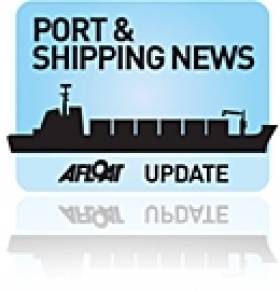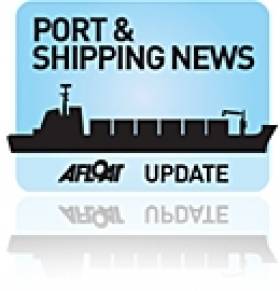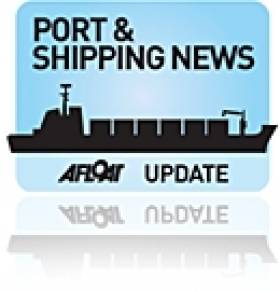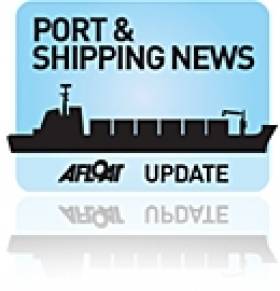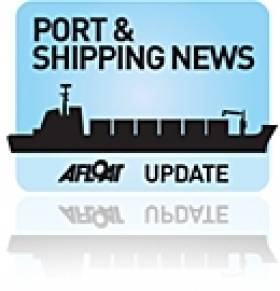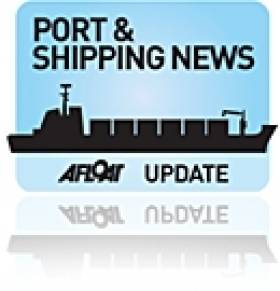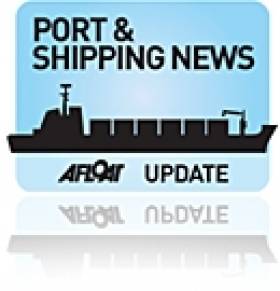Displaying items by tag: Port and Shipping News
Container Shipping Volumes Rose 9% in Q3 2014
#ContainerRiseVolume – According to the Irish Maritime Development Office (IMDO) container shipping volumes, Lo/Lo have rose by 9% in Q3 of 2014.
Ro/Ro experienced a 6% growth and Break Bulk volumes grew by 16%. This is in contrast however to total traffic volumes through Irish ports which fell by 3% overall in Q3, when compared to the same period last year. This decline is captured in the iShip index which fell to 818 points in the period under review. The reduction in total volumes is attributable to the Dry Bulk and Liquids sectors and in particular to lower trade volumes in commodities such as coal, oil and fertilizer.
Activity in the Dry Bulk market generally dips in Q3, however, the decrease this year was more pronounced with volumes dropping to 3,290,393 tonnes, their lowest level since Q3 2012. A decline in coal imports was the largest contributory factor to the drop in the Dry Bulk volumes, while Liquid Bulk volumes fell by 16%, largely as a result of reduced oil imports. The markets for commodities such as coal and oil were influenced by mild weather conditions.
For the sixth quarter in a row the Ro/Ro sector has grown (up 6% on Q3 last year). Furthermore, Lo/Lo volumes increased 9% in Q3, the highest quarterly growth rate recorded in this traffic mode since 2007. As the majority of consumer goods are transported on Ro/Ro and Lo/Lo services, increases in traffic volumes on these modes support findings of improved consumer sentiment in the Irish economy. In September 2014, the KBC Ireland/ESRI Consumer Sentiment Index rose to 92.8, its highest level since January 2007.
In the Lo/Lo sector, laden imports rose by 13% in Q3, buoyed by a marked increase in demand for consumer goods from the Far East.
Ro/Ro freight volumes increased by 6% to 239,380 units in Q3, with 86% of this volume moving on services between Ireland and Great Britain. Ro/Ro traffic on direct services to the continent has been sluggish for the first three quarters of 2014, with a year on year growth of less than 1% recorded.
Break Bulk, which largely consists of imports of construction and project related materials, increased by 16%. Break Bulk has now seen five consecutive quarterly increases, supporting the view that the construction industry is experiencing sustained growth, albeit from a low base.
For a summary of freight traffic trends for the Republic of Ireland (see graph) and for more information and the role of the IMDO, visit their website HERE.
Seafarers & Shore-Staff Recount Tales at Irish Shipping Ltd Reunion
#ISL30thReunion- Irish Shipping Ltd, the state-owned deep-sea shipping company that was liquidated 30 years ago was marked by former employees attending a reunion that was held on Friday in the Conrad Hotel, Dublin, writes Jehan Ashmore.
In recognition of the date's significance (14 November 1984) in Irish maritime affairs, the reunion attracted around 80 former seafarers and shore-staff. Despite the rather inclement weather they gathered at the city-centre venue to commemorate the event.
The origins of ISL stem from the outbreak of WW2 in 1939 which led to the Irish Government in 1941 to incorporate the state-shipping company. It was realised the stark reality of not having an Irish flagged fleet to meet the strategic importance of ensuring critical food and cargoes supplies to our dependent island. To distinguish Ireland's neutral position, the ships had the Irish flag and 'Eire' painted on the hulls.
According to Gerry McGovern, the reunion was attended by many Captains and stealing the show was Able Seaman, Desmond Brannigan who sailed in the Irish Poplar in 1941. A young photographer at the event asked Des, "Did the ship have the Irish colours painted on the side?" "It sure did" said Des, "we were bringing food to this country while fellows were trying to kill us, but we made it". Des is one of the last to brave the North Atlantic on an Irish flag ship during the war.
In 1942 the Irish Pine was sunk by U-Boat torpedo with the loss of all 33 crew members. A year later, Irish Oak was also a victim yet fortunately all crew were saved by fleet-mate Irish Plane and taken ashore to Cobh. Asides the stricken ISL ships, there were an additional 14 vessels from the Irish-registry lost during WW2.
Returning to the reunion, a mix of those who served a career at sea from throughout the various departments of deck, engine and catering chatted along with shore-staff office personnel. It was a night to remember, with lots of sea stories being told and some from a time long past!
Also in attendance were the four Wexford authors who produced the excellent book, 'Irish Shipping Ltd- A Fleet History'. The publication traces all the vessels of the grey-hulled fleet that reached the four corners of the world and proudly under the Irish flag!
ISL's fleet numbered 51 during the course of the company's 43 year existence. They were given a naming theme, where the prefix 'Irish' was followed by a name of a tree species. Examples, been the Irish Ash (painting by Kenneth King), Larch and Willow. There was the exception with two 'Star' vessels that were built for long-term charter.
As the company spanned several decades, most of these ship names were repeated and became well known in Irish shipping circles and in ports throughout foreign shores.
As previously referred, the Irish Willow (3) was a general cargoship of 1,743 tonnes built in Scotland and her sister Irish Fir was built at the former Liffey Dockyard Ltd. The current related business albeit in the form of ship-repair and maintenance firm Dublin Graving Docks Ltd is located nearby to the site of the old shipyard in Alexandra Basin.
The dry dock is currently occupied by an Arklow Shipping Ltd vessel, the dry-cargo bulker Arklow Willow (click report and for photo), whose name is aptly similar to ISL's vessel tree naming theme.
She is the only ASL ship to feature a 'tree' name from a 45-strong fleet that is in the majority under the Irish tricolour with the balance Dutch-flagged.
Ports & Shipping Review: EPSO Re-Elect Chairman, Ardmore's Finance Plan, Green Port Award, New Foynes Jetty, Double Ship Incidents and ISL 30th Anniverary
#Ports&ShippingReview: Over the last fortnight, Jehan Ashmore has reported on the shipping scene, where the European Sea Port Organisation (ESPO) re-elected Garcia-Milà as Chairman following a vote of the organisation's General Assembly held in Brussels.
Tanker fleet operator Ardmore Shipping Corporation announced financial results and a $20 million Share Repurchase Plan.
As referred above ESPO, has awarded this year the Slovenian port of Koper in recognition of its environmental work in creating a sustainable future for the port and its surroundings.
The name of the contractor for a €10m plus upgrade of the east jetty at Foynes will be announced shortly by Shannon Foynes Port Company.
Within a fortnight two separate incidents involving a pair of vessels berthed in Warrenpoint, took place at the Co. Down port. The first incident was an oil spill followed by an overheating cargo of animal feed.
A cargoship currently berthed in Dublin Port, Arklow Willow has a similar name to a former Irish Shipping Ltd vessel, the Irish Willow. The timing is apt given yesterday a staff reunion in the capital marked the 30th anniversay of the liquidation of Irish Shipping Ltd.
Similar Named Ships Highlight 30th Anniversary Closure of Irish Shipping Ltd
#ArklowWillow- According to organisers of a Irish Shipping Ltd reunion this evening in Dublin, today marks the 30th anniversary of the liquidation of the former state-owned shipping company in 1984, writes Jehan Ashmore.
Following the outbreak of WWI in 1939, the Irish Goverment realised the perilous state of not having a strategic fleet under its control and so led to the formation of ISL which secured vessels to bring strategic vital food supplies to the shores of our dependent island.
As the decades passed a deep-sea global fleet developed. These Irish flagged ships were named from a theme based on tree species, for example Irish Willow. She was a general cargo ship of some 1,700 tonnes that served a career with the company from 1956 to 1969.
It is apt that an Irish cargoship currently has almost the same name, the Arklow Willow which is berthed in Dublin Port undergoing routine maintenance. In addition that the Arklow Shipping Ltd owned drybulk cargoship should be the only vessel from a 45-strong fleet to be named after a type of tree too!
At the time of ISL's collapse this day three decades ago on 14 November 1984, the state-company had only 7 vessels in service.
Arklow Willow is the final sister of a trio of 'W' class Japanese built vessels berthed in Dublin Graving Dock Ltd. At 14,001 dwt Arklow Willow is the largest in this class, though there are larger fleetmates also in terms of deadweight tonnes.
They are the South Korean newbuilds Arklow Spirit as previously reported (and newer sister Spray) at 34,919dwt and are also the largest Irish-flagged cargoships notably since the sad demise of ISL.
Arklow Willow had recently arrived from Corunna, north-west Spain and the 136m long vessel occupies the 200m long Graving Dock No.2. This differs to last month's double dry-docking as previously reported of the smaller Arklow Ranger and Jeanie Johnston, which shared the dry-dock located in Alexandra Basin.
Dublin Port Company have submitted plans to re-develop the basin costing €200m which would form phase one of the port's Masterplan 2040. The project would involve the re-use of the site of the drydock which as a result would face closure.
Overheating Ship's Cargo Hold and Oil Spill Incidents at Warrenpoint
#Vesselincidents - Within a fortnight two separate incidents involving a pair of vessels berthed in Warrenpoint, took place at the Co. Down port on the shore of Carlingford Lough.
Last week, overheating of cargo on board a hold of the M.V. Cimbris was detected by the vessel's captain who informed Warrenpoint Harbour Authority (WHA) which requested the fire brigade service.
The port authority implemented their emergency response plan and several units from the Northern Ireland Fire and Rescue Service were dispatched to the Cimbris which had arrived from Riga.
Peter Conway, CEO of the port authority confirmed that of the 3,000 tonnes of animal feed, 2000 tonnes had already been discharged prior to the incident on board the vessel whose berth was cordoned off for safety reasons.
Commenting on the incident, "I wish also to compliment the speed with which the emergency services responded to this incident".
The second incident as previously reported on Afloat.ie, had involved a small discharge of marine fuel from a vessel berthed at the port on 22 October.
The fuel was detected on the water's surface by the ship's captain who informed WHA which led to the port activating their oil contingency plan.
A team trained in oil spill recovery put in place around the vessel oil spill booms in addition to securing the affected area through the deployment of absorbent pads.
With a rising tide some oil had been detected along the shore adjacent to Narrow Water, the area was subsequently cleaned and oil residue removed as part of the port's contingency plan.
The Northern Ireland Environmental Agency, the Department of the Environment, Newry and Mourne District Council, the Loughs Agency and other agencies were informed. They assisted Warrenpoint Harbour in the remediation of the shore line at this location.
An investigation into the spill was instigated to determine the cause of the incident.
Garcia-Milà Re-Elected as European Sea Port Organisation Chairman
#EPSOchairman - Santiago Garcia-Milà has been unanimously elected for a second term as Chairman of the European Ports Organisation (ESPO) following a vote of the organisation's General Assembly held in Brussels this afternoon.
The General Assembly also elected Annaleena Mäkilä and Eamonn O'Reilly as Vice-Chairs.
Mr. O'Reilly, who serves as the Chief Executive of the Dublin Port Company, will now start a second term in the role. Ms. Mäkilä is currently Executive Director of the Finnish ports Association.
Santiago Garcia-Milà starts his second term as Chairman of ESPO, following his tenure for the years 2012-2014.
Upon his re-election, Mr Garcia-Milà said "the last two years were quite challenging for ESPO, both with a new port regulation proposal on the table and the development of a new TEN-T policy framework. On both topics, ESPO has succeeded, notwithstanding the diversity of its ports, in taking a solid position and work in a professional way with EU policy makers towards a better policy".
The work is not finished, he added. "I hope we can continue on this path, explain to EU policy makers how ports function, share our knowledge and our experience and convince Europe's decisions makers that Europe's ports work. I am happy to contribute to this work for two more years and would like to thank ESPO members for this vote of confidence".
Mr.Garcia-Milà is currently Deputy General Manager of the Port of Barcelona, in addition to being Vice-President of the International Association of Ports and Harbours (IAPH), the President of Barcelona's Port Community System, PortIC, Chief Executive Officer of tmZ, Zaragoza Inland Terminal and associate lecturer in International Marketing at the University of Barcelona.
The election of Mr. Garcia-Milà coincides with the publication of ESPO's Annual Report 2014, which outlines the activities of the organisation over the past year. A copy of the report can be downloaded HERE.
In addition, tonight will see the awarding of the sixth annual ESPO Award on Societal integration, as previously reported on Afloat.ie. The winner will be announced by Joao Aguiar Machado, Director General, DG MOVE, at a ceremony at the Albert Hall in Brussels.
The theme of this year's ESPO Award is 'Innovative Environmental projects'. The shortlisted candidates are the Ports of Huelva, Koper, Lisbon, Marseille and Rotterdam.
Ports & Shipping Review: Cork Environment Recognition, Arklow’s ‘Green’ Bay, Bantry €24m Redevelopment, EU Co-Fund Dublin Port Studies
#Ports&ShippingReview: Over the last fortnight, Jehan Ashmore has reported on the shipping scene, where the Port of Cork achieved a (PERS) Port Environmental Review System certification.
Among the other ports awarded the PERS certification was Moerdijk, the Dutch port which is to where Arklow Rally was bound this week having departed Dublin Port. The general cargo ship had docked in Alexandra Basin along with fleetmates Arklow Ruler and notably the 'green' newbuild Arklow Bay which features a 'bulb-less' bow to optimise hull performance in varying sea-states.
Port Cork Company is to embark on phase one of a €24m redevelopment of Bantry Harbour which will encourage more seaborne trade and cruise line business.
The EU TEN-T Programme will co-fund almost €2.5 million for studies on capacity development of Dublin Port.
Arklow ‘Green’ Newbuild Brings to Three ASL Ships in Dublin Port
#GreenNewbuild - Arklow Bay which was launched in March and now in service docked in Dublin Port today having sailed from Bordeaux on Monday, writes Jehan Ashmore.
The 119m long general cargoship which features green credential notably a 'bulb-less' bow which is to optimise effiencies. She is one of six 'B' class 4,800dwt newbuilds which Arklow Shipping have contracted to Ferus Smit B.V. in The Netherlands.
Her sideways or in shipping parlance amidships entry into the water took place at the shipbuilding facility in Westerbroek from where leadship Arklow Bank was launched in January.
It is understood that Arklow Bay berthed at the dry bulk-facility in Alexandra Basin and adjacent to her is fleetmate Arklow Ruler moored at the Boliden Tara Mines terminal jetty. Once loading of zinc-ore deposits is completed she is to head for the Norwegian smelting works at Odda.
Earlier today a third vessel belonging to ASL's Irish and Dutch flagged fleet totalling some 45 vessels included that of another 'R' class, Arklow Rally which this afternoon is bound for Moerdijk.
#ShannonFoynes - The Limerick Leader reports on the Shannon Foynes Port Company's announcement of record profits in 2013.
Ireland's second largest bulk port company declared a 35% increase in its operating profits in the 12 months since its 2012 annual report, a record rise for the fourth successive year.
According to the port's CEO Patrick Keating, this strong performance underlines the objectives of the Vision 2041 master plan for the Shannon Estuary launched last year.
The Limerick Leader has more on the story HERE.
Beacon of Green Light Shines As Arklow Newbuild Launched
#ArklowGreenNewbuild- This afternoon Arklow Shipping's fourth out of a total of six 4,800dwt newbuilds, Arklow Beacon was launched from a Dutch shipyard, writes Jehan Ashmore.
She features a 'green' credential designed hull form which was given a 'sideways' launch. No doubt a proud moment for ASL officials, dignitaries and yard workers alike attending the ceremony at the Ferus Smit yard at Westerbroek.
The German shipbuilding firm's Dutch yard was contracted by ASL to build the series of the 119m long multi-purpose bulk orientated general cargoships. The class have a hull form that was chosen to adapt the 'bulbless' principle; creating a slender bow without bulb.
Her design also takes into account various loading drafts and wave conditions to be encountered in service. The performance of this bow will be better suited than a bulb optimised for one single draft operations and when on flat water only.
Arklow Beacon is to join the Irish company's Dutch subsidiary in October under the management of Arklow Shipping Netherlands B.V. based in the Rotterdam. Likewise of her sisters, in which Arklow Beach was the last to be completed in June, flies the flag of the Netherlands.
Classed under Bureau Veritas, the newbuilds have a two-hold grain capacity of 9902,6m³ and for bale of 349.706ft³.
She will mainly be employed in the shipment of wheat, corn and other bulk commodities in European waters. A speed of 13 knots will be delivered from a Mak engine.


























